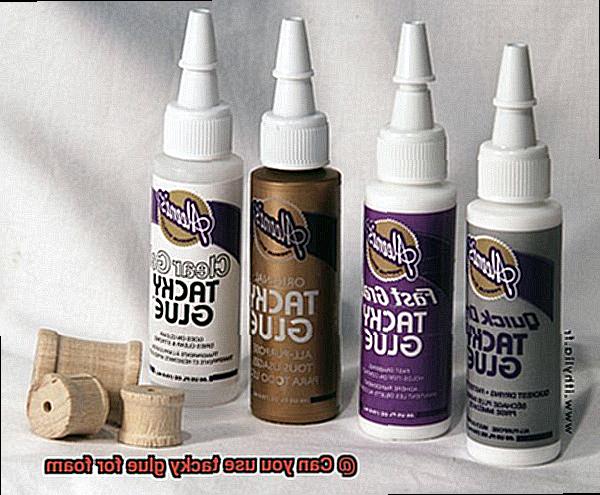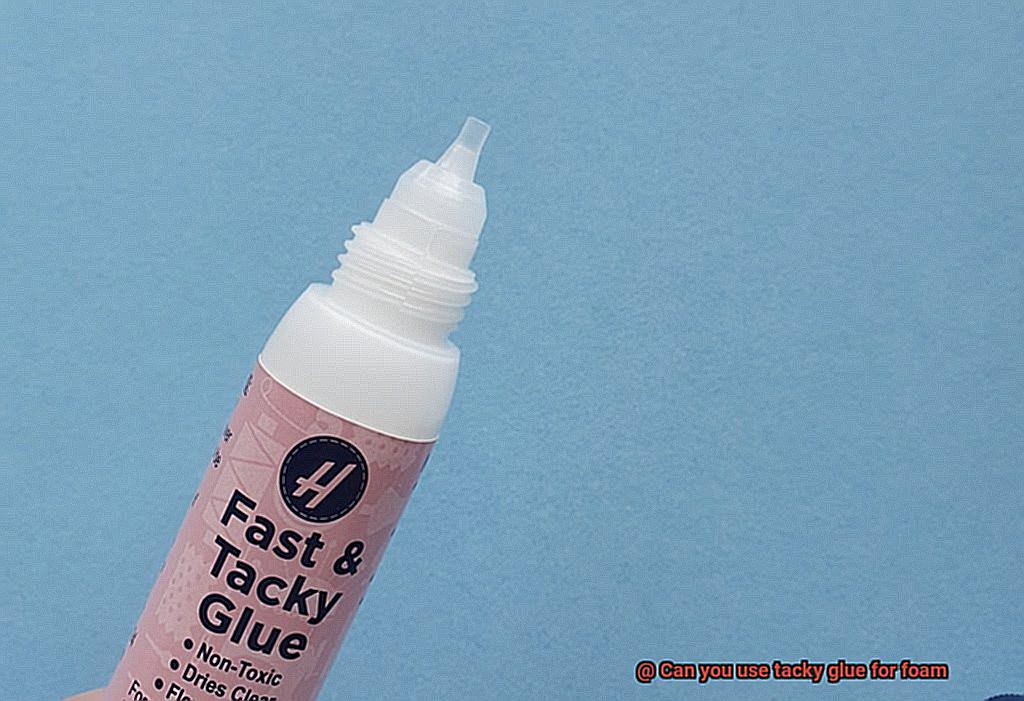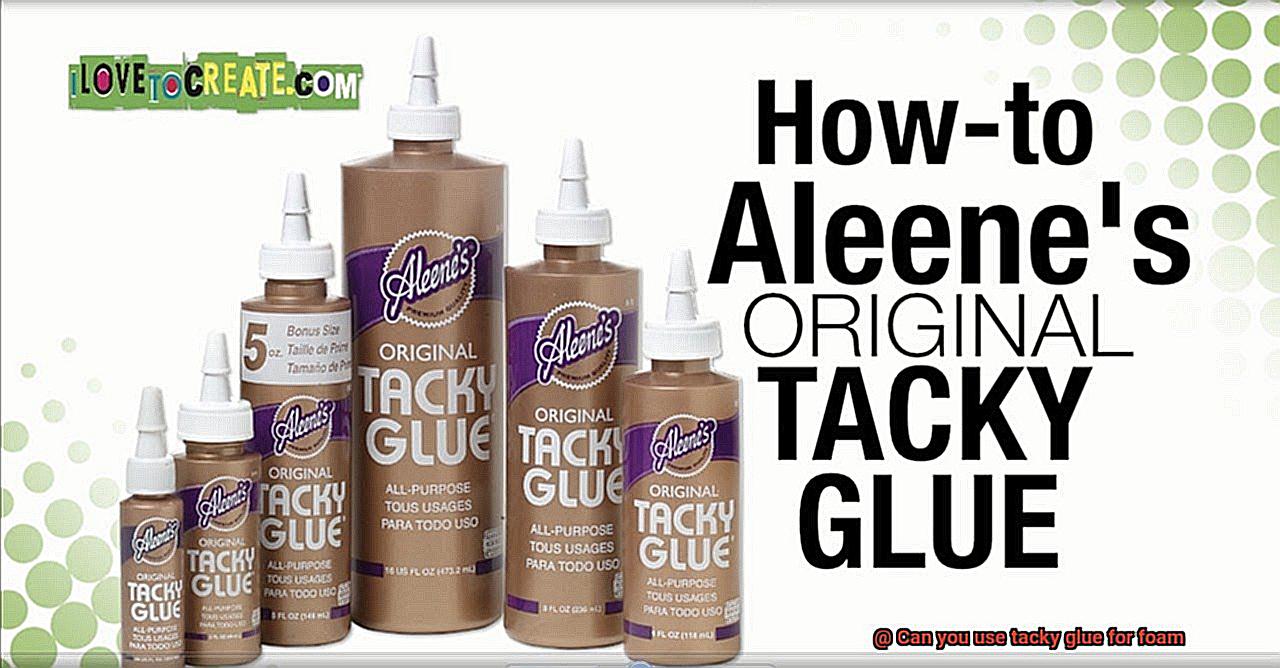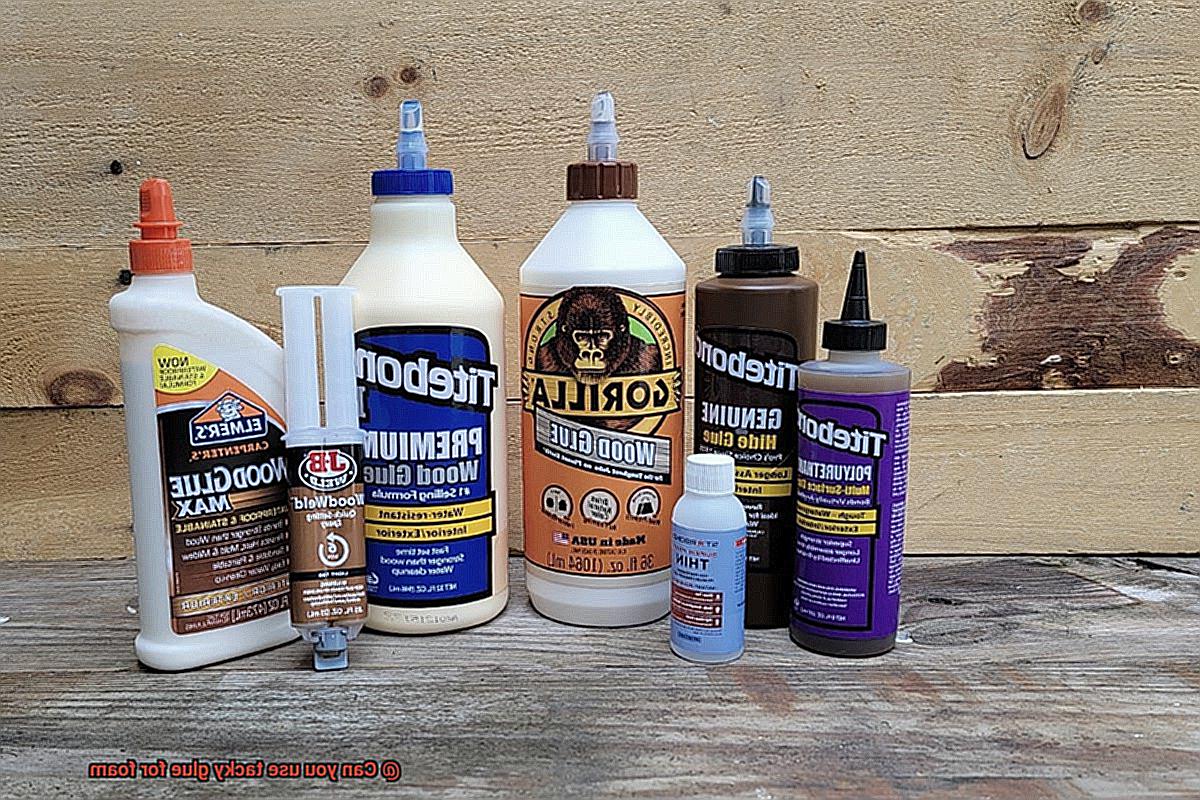If you’ve ever wondered if this sticky stuff is a good match for your foam projects, you’re in the right place. Foam is an amazing material that’s used in everything from crafts to packaging to even cosplay.
And when it comes to sticking those foam pieces together or attaching them to other surfaces, having the right glue is key. Tacky glue is a popular choice because it’s super versatile and easy peasy to use.
But does it really do the trick? In this post, we’ll dive into all the nitty-gritty details of using tacky glue for foam – the good, the not-so-good, and some handy tips to make sure your bond stays strong.
So, grab your foam projects and let’s get this stickiness started.
What is Tacky Glue?
Contents
- 1 What is Tacky Glue?
- 2 What is Foam?
- 3 Advantages of Using Tacky Glue for Foam Projects
- 4 Disadvantages of Using Tacky Glue for Foam Projects
- 5 Types of Foam and Their Suitability with Tacky Glue
- 6 Testing the Compatibility of Tacky Glue with Your Foam Material
- 7 Specialized Adhesives for Bonding Foam Materials
- 8 Conclusion
Look no further than tacky glue. In this blog post, we will embark on a journey through the world of tacky glue, exploring its properties, uses, advantages, and even its compatibility with foam-based crafting projects.
Properties and Uses:
Tacky glue, also known as craft glue or PVA glue, is a thick, white adhesive with a unique tacky or sticky texture. Its distinctive characteristics make it a must-have for crafters of all skill levels. Tacky glue dries clear and flexible, making it suitable for a wide range of crafting projects, from scrapbooking and card-making to fabric crafts and lightweight material bonding.
Advantages:
The versatility of tacky glue is truly remarkable. It adheres to various surfaces, including paper, fabric, wood, and some plastics. This makes it an ideal choice for crafters who love to explore different materials and experiment with their creativity. Unlike other glues, tacky glue offers a longer drying time, allowing for repositioning and adjustment of materials before the bond becomes permanent. This feature is particularly useful in intricate or delicate projects that demand precision.
Cleanup is a breeze with tacky glue since it is water-soluble when wet. Excess glue can be easily wiped away with just a damp cloth, leaving behind a clean and polished finish on your project.
Choosing the Right Tacky Glue:
It’s important to note that different brands and formulations of tacky glue exist in the market. Factors like drying time, bond strength, and suitability for specific materials may vary. To achieve optimal results, carefully read the instructions and recommendations provided by the manufacturer before using tacky glue for any particular project.
Bonding Foam with Tacky Glue:
Foam is a versatile material commonly used in crafting projects. Many crafters wonder if tacky glue can effectively bond foam. The answer lies in the type of foam being used. Tacky glue works wonders with open-cell foam, which has a more porous structure, allowing the adhesive to penetrate and create a strong bond. However, closed-cell foam, with its denser and smoother surface, may not adhere as effectively to tacky glue.

What is Foam?
Foam, the extraordinary material that adds a touch of magic to our lives. It’s like the glue that holds everything together, both literally and figuratively. But what exactly is foam?
Foam is a lightweight substance composed of tiny air bubbles trapped within a solid matrix. It’s like a sponge, but way cooler. These air bubbles give foam its unique properties – elasticity, cushioning, insulation, and buoyancy. It’s like having your cake and eating it too.
But how is foam made? Well, it’s a bit like a science experiment. Bubbles or cells are created within a liquid or solid material by introducing gas or a foaming agent. This causes the material to expand and form that signature porous structure we all know and love. It’s like a bubbly party in there.
Foam can be made from different materials, such as polyurethane, polystyrene, latex, and rubber. Each type of foam has its own special characteristics and is used for specific purposes. For example, polyurethane foam is all about comfort and durability, making it the perfect choice for cozy furniture and dreamy bedding. On the other hand, polystyrene foam is a master of thermal insulation and is often found keeping your home cozy and your packages safe.
Now that we’ve covered the basics of foam, let’s dive into the world of glue. Tacky glue is a thick adhesive that forms a strong bond between materials. But when it comes to foam, not all glues are created equal.

You see, foam is a bit of a diva when it comes to adhesives. Its porous nature can absorb liquid glues, which can lead to uneven spreading or even weak spots in the structure. Nobody wants a wobbly masterpiece. Some glues may also contain solvents or chemicals that could harm or dissolve certain types of foam. Yikes.
So, is tacky glue the one for foam? Well, if you’re working with open-cell foam, it’s a match made in crafting heaven. The porous structure allows the glue to penetrate and create a strong bond. But if you’re working with closed-cell foam, you might want to explore other adhesive options.
There are specialized adhesives designed specifically for foam, like foam glue or adhesive sprays. These options are formulated to bond foam materials without any fuss. So, if you’re serious about your foam creations, it might be worth checking them out.
Advantages of Using Tacky Glue for Foam Projects
Foam crafts have taken the crafting world by storm, and it’s no wonder why. Foam is a versatile material that can be shaped, molded, and crafted into all sorts of amazing projects. But when it comes to keeping your foam creations intact, choosing the right adhesive is crucial. That’s where tacky glue comes in, and let me tell you, it’s a game-changer.
First off, tacky glue boasts a bond that is as strong as Hercules himself. When you’re working with foam, you need an adhesive that will hold everything together securely. Tacky glue does just that, forming a bond that can withstand even the most intense pressure. So there’s no need to worry about your foam masterpiece falling apart like a house of cards.
But that’s not all – tacky glue also works its magic in record time. Unlike other adhesives that take ages to dry, tacky glue dries faster than a cheetah on roller skates. This means you can keep on crafting without having to twiddle your thumbs while waiting for glue to set. It’s like having your very own time-saving superhero.
And talk about versatility. Tacky glue is a master of all trades when it comes to foam. Whether you’re working with Styrofoam, EVA foam, or craft foam, this adhesive has got your back. No need to clutter up your craft space with multiple types of glue – tacky glue is the one-stop-shop for all your foam needs.
But wait, there’s more. Tacky glue is not only easy to use, but it’s also safe for everyone involved. Its precise application makes it a breeze to use, and its non-toxic formula ensures that your crafting adventures won’t turn into a health hazard. So go ahead and get your creativity flowing without any worries.
Flexibility is another feather in tacky glue’s cap. Even after drying, it remains flexible, allowing your foam projects to maintain their shape and resilience. No need to sacrifice style for durability – tacky glue gives you the best of both worlds.
Last but certainly not least, tacky glue is readily available and won’t break the bank. You can find it in craft stores and online retailers, making it easily accessible for all your foam projects. And with its affordable price tag, you won’t have to worry about emptying your pockets just to stick some foam together.
Disadvantages of Using Tacky Glue for Foam Projects
Imagine you have a foam project in mind, ready to bring your artistic vision to life. Before you grab that familiar bottle of tacky glue, take a moment to consider if it’s truly the best adhesive for the job. While tacky glue is a go-to choice for many crafts, it may not be the superhero it claims to be when it comes to foam. Let’s dive into the five reasons why tacky glue may not stick with foam projects:
- Feeble Bonds: Foam is a porous material that demands a robust adhesive to ensure a secure and long-lasting bond. Regrettably, tacky glue may not deliver the necessary strength and durability required for foam projects. It’s like attempting to hold up a skyscraper with a toothpick – it simply won’t cut it.
- Sluggish Drying Time: Foam projects often necessitate swift drying times to maintain their shape and hold pieces together. However, tacky glue tends to dry slowly, leading to shifted or separated foam pieces before the glue sets. It’s like waiting for water to boil – ain’t nobody got time for that.
- Sticky Residue: Tacky glue can leave behind an unpleasant sticky residue on foam surfaces. This can be a real downer if you’re aiming for a clean and polished look. Nobody wants their masterpiece covered in sticky goo – it’s like spreading honey on your sandwich instead of mayo. Just… no.
- Lack of Waterproofing: Foam projects that encounter water or face humid environments require an adhesive that can handle moisture. Unfortunately, tacky glue is not waterproof or resistant to moisture, causing the adhesive to weaken or break down over time. It’s like using an umbrella made of tissue paper during a rainstorm – it won’t keep you dry.
- Inflexible Bonding: Foam is flexible and demands an adhesive that can accommodate its movements without cracking or breaking. Tacky glue may not provide a flexible bond for foam projects, resulting in a brittle connection that easily snaps under stress. It’s like trying to do yoga in jeans – you simply can’t stretch and bend properly.
Types of Foam and Their Suitability with Tacky Glue
Foam is a versatile material that is commonly used in various crafting and DIY projects. However, not all types of foam are the same, and their suitability with tacky glue can vary. It is important to understand the different types of foam and how well they adhere to tacky glue.
Polystyrene Foam
Polystyrene foam, also known as Styrofoam, is a popular choice for crafting and model-making. It is lightweight, easy to cut, and can be shaped into various forms. When it comes to using tacky glue with polystyrene foam, it is important to note that some types of tacky glue can dissolve or melt the foam.
This can result in a messy and ineffective bond. It is recommended to use a low-temperature hot glue gun or a special adhesive designed for polystyrene foam instead.
EVA Foam
Ethylene-vinyl acetate (EVA) foam is another commonly used foam material in crafting and cosplay projects. It is soft, flexible, and durable, making it ideal for creating costumes, props, and accessories. Tacky glue generally adheres well to EVA foam, providing a strong bond. However, it is important to ensure that the glue is evenly spread and applied to the surface of the foam for optimal adhesion.
Craft Foam

Craft foam, also known as foam sheets or foam paper, is a thinner and more pliable type of foam. It is often used in scrapbooking, card making, and other paper crafts. Tacky glue is suitable for bonding craft foam together or attaching it to other materials such as paper or fabric. The glue should be applied thinly and evenly to prevent any excess from seeping through the porous surface of the foam.
Upholstery Foam
Upholstery foam is commonly used in furniture padding and cushioning. It is a denser and thicker foam that requires a strong adhesive for proper bonding. While tacky glue can be used to adhere upholstery foam, it may not provide the strongest bond. It is recommended to use a specialized foam adhesive or contact cement for upholstery foam to ensure a durable and long-lasting bond.
Closed-Cell Foam
Closed-cell foam, such as neoprene or polyethylene foam, is often used for insulation, flotation devices, and outdoor gear. Due to its closed-cell structure, it is less porous and may not adhere well to tacky glue. It is best to use an adhesive specifically designed for closed-cell foam, such as a contact adhesive or a two-part epoxy.
Testing the Compatibility of Tacky Glue with Your Foam Material
It’s crucial to test the compatibility of the glue with your foam material to ensure a strong and durable bond without compromising the integrity of the foam. Let’s explore the process of testing compatibility in more detail.
- Research: Different types of foam may react differently to adhesives, so it’s important to choose the right glue for your specific foam material. Consult the manufacturer or supplier of your foam material for recommendations on suitable adhesives.
- Test Area Selection: Choose a small, inconspicuous area of the foam to apply the glue. This could be a corner or an edge that won’t be easily noticeable if any damage occurs.
- Glue Application: Use a brush or applicator to apply a small amount of tacky glue to the chosen test area. Ensure that the glue is spread evenly and covers the entire surface.
- Drying Time: Allow the glue to dry completely according to the manufacturer’s instructions. Patience is key here, as accurate results require sufficient drying time, which may take several hours or even overnight.
- Examination: Carefully examine the test area for any signs of damage once the glue has dried. Look out for discoloration, warping, or changes in texture. These may indicate that the glue is not compatible with your foam material.
- Peel Test: Gently try peeling off the glue from the test area. A compatible tacky glue should adhere firmly to the foam and not easily peel off. If it comes off effortlessly or leaves residue on the foam, it may not be suitable for your particular foam material.
- Consider Foam Properties: Different types of foam may require different bonding techniques. Open-cell foam may absorb more glue and need additional coats for a strong bond, while closed-cell foam may have a smoother surface that allows for better adhesion. Take these properties into consideration when choosing your tacky glue.
Specialized Adhesives for Bonding Foam Materials
Specialized adhesives play a crucial role in bonding foam materials, offering unique properties that create strong and durable bonds. While tacky glue is commonly used for general crafting purposes, it may not be the best option for bonding foam materials.
Foam materials, like polyurethane foam or expanded polystyrene (EPS), have a cellular structure that presents challenges for certain adhesives to effectively bond with them. Tacky glue, being water-based, may struggle to fully penetrate the foam’s surface, resulting in weak bonds that can easily break or peel away over time.
Moreover, tacky glue may not withstand the stress and strain that foam materials endure. Foam is often used in applications where it needs to provide cushioning, support, or insulation, exposing it to compression, stretching, or impact forces. Tacky glue lacks the necessary strength and flexibility to withstand these forces, leading to bond failure.
Fortunately, specialized adhesives are available specifically formulated for bonding foam materials. These adhesives have low viscosity, allowing them to penetrate the porous surface of the foam and form a strong bond. Typically water-based, they provide flexibility and durability.

Options such as spray adhesives offer a convenient way to bond foam materials. They come in aerosol cans and can be easily sprayed onto the foam surface. Spray adhesives cover large areas evenly, but it’s important to choose one suitable for foam bonding.
Another popular choice is contact adhesive. This type comes in liquid form and requires application on both surfaces being bonded. Once dried, the two surfaces can be pressed together to create a strong and permanent bond. Contact adhesives excel in bond strength and flexibility.
YCIYMVOMBso” >
Also Read: What Is the Best Glue For Styrofoam? – Glue Things
Conclusion
In conclusion, the use of tacky glue for foam projects can be effective, but its success may vary depending on the type of foam being used. Tacky glue, also known as craft glue or PVA glue, is a versatile adhesive that sticks well to different surfaces and dries transparent and flexible. It’s a suitable choice for open-cell foam due to its ability to penetrate and create a strong bond within the foam’s porous structure. However, when it comes to closed-cell foam with its denser and smoother surface, tacky glue may not adhere as effectively.
To ensure optimal results when using tacky glue for foam projects, it’s crucial to apply it evenly and thinly. This prevents excess glue from seeping through the foam’s porous surface. Additionally, selecting the appropriate type of tacky glue for your specific foam material and carefully following the manufacturer’s instructions are essential steps.
While tacky glue offers advantages such as strength, versatility, ease of use, and affordability, it does have some drawbacks in bonding foam. These include potentially weak bonds, slow drying time, sticky residue, lack of waterproofing capabilities, and inflexible bonding.
For superior outcomes in bonding foam materials, specialized adhesives specifically designed for this purpose are recommended. These adhesives possess low viscosity to deeply penetrate the porous surface of the foam and establish a robust and long-lasting bond. Popular options like spray adhesives or contact adhesives are often preferred when working with foam materials.






